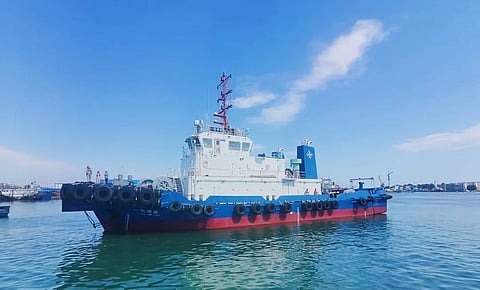VESSEL REVIEW | Yihang Jinyuan – New Chinese offshore tug fitted with AI-enabled systems
China Communications Construction Company (CCCC) recently took delivery of a new offshore tug for operation by its CCCC First Harbour Engineering Bureau.
Yihang Jinyuan (一航津远) will be used for deep-sea towing of large vessels, short-distance towing in coastal waters, and anchor handling.
The tug has an LOA of 45 metres (150 feet), a beam of 11.5 metres (37.7 feet), a design draught of four metres (13 feet), and a moulded depth of 5.2 metres (17 feet). Two diesel engines that each produce 3,000 kW (4,000 hp) drive azimuthing propellers to deliver a top speed of 12.7 knots and a bollard pull of approximately 51 tonnes.
A range of 2,500 nautical miles enables the tug to tow vessels over long distances in deep-sea waters. This also ensures that the tug has the necessary endurance to operate for sustained periods offshore without requiring repeated bunkering.
AI-enabled technologies to ensure safer navigation
The most notable feature of the tug is its artificial intelligence (AI) systems, which will aid the vessel’s multi-sensor intelligent navigation assistance and visual image functions. The tug also boasts an integrated information system, an intelligent engine room, a fuel consumption monitoring system, LAN wireless coverage, and navigation data collection and storage systems.
The AI systems’ most important function is in assisting the crew in the safe operation of the tug. As the crew is focused on towing and other activities, risks are still prevalent as there are a number of factors that also need to be addressed such as blind spots and fatigue (caused by long operating periods).
The AI therefore works in conjunction with the night vision sensors and an array of wide-angle cameras that provide a full 360-degree view around the tug to enable the crew to detect, identify, and avoid obstacles with ample early warning. The technology can be employed during berthing/unberthing and when navigating in open waters.
The tug will operate on the premise of precise ship control day or night and even in bad weather. The radar and the night vision sensor can be linked with each other so that any obstacles in the water detected by one sensor can also be instantaneously seen by the other. This then presents the crew with a clearer picture of the surroundings, thus enhancing their situational awareness for greater safety especially when navigating in low visibility.
Enhanced image collection sensors
A dual-axis, gyroscope image stabilisation function meanwhile permits the recording of stable video footage. This ensures the visual sensors can take clear, stable footage even as the tug is rocked by strong winds and currents.
Design work on Yihang Jinyuan was undertaken in compliance with China Classification Society rules. Construction took place at CCCC First Harbour Engineering Bureau’s own Ship Machinery Centre in Qinhuangdao in Hebei province.


